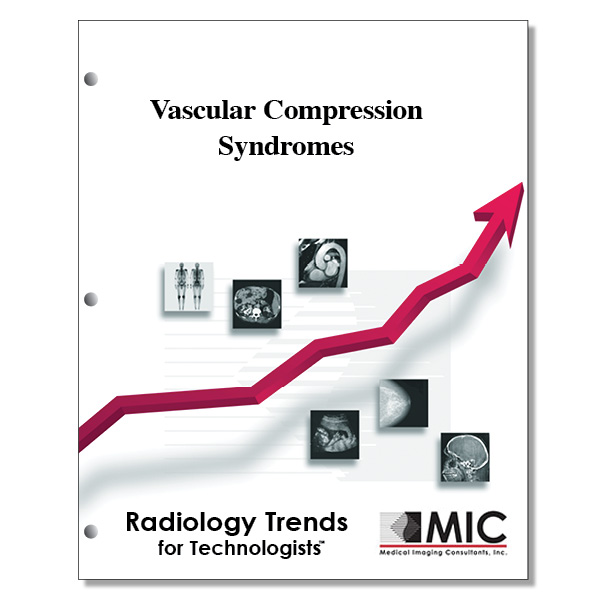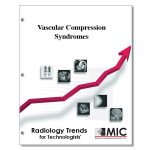

Vascular Compression Syndromes
Clinical and imaging features are reviewed when vessels are entrapped between rigid or semi-rigid surfaces in a confined anatomic space.
Course ID: Q00349 Category: Radiology Trends for Technologists Modality: Vascular Interventional3.75 |
Satisfaction Guarantee |
$37.00
- Targeted CE
- Outline
- Objectives
Targeted CE per ARRT’s Discipline, Category, and Subcategory classification:
[Note: Discipline-specific Targeted CE credits may be less than the total Category A credits approved for this course.]
Computed Tomography: 2.75
Procedures: 2.75
Head, Spine, and Musculoskeletal: 0.75
Neck and Chest: 1.25
Abdomen and Pelvis: 0.75
Magnetic Resonance Imaging: 2.75
Procedures: 2.75
Body: 2.00
Musculoskeletal: 0.75
Registered Radiologist Assistant: 3.75
Procedures: 3.75
Neurological, Vascular, and Lymphatic Sections: 3.75
Sonography: 2.75
Procedures: 2.75
Abdomen: 0.75
Superficial Structures and Other Sonographic Procedures: 2.00
Vascular-Interventional Radiography: 3.75
Procedures: 3.75
Vascular Diagnostic Procedures: 3.75
Vascular Sonography: 2.75
Procedures: 2.75
Abdominal/Pelvic Vasculature: 1.50
Arterial Peripheral Vasculature: 0.50
Venous Peripheral Vasculature: 0.50
Extracranial Cerebral Vasculature and Other Sonographic Procedures: 0.25
Outline
- Introduction
- Thoracic Outlet Syndrome
- Anatomy
- Pathophysiology
- Symptoms and Signs
- Diagnostic Evaluation
- Radiologic Imaging
- Radiography
- Doppler US
- CT Angiography
- MR Angiography
- Conventional Angiography
- Management
- Paget-Schrotter Syndrome
- Quadrilateral Space Syndrome
- Imaging Evaluation
- Conventional Angiography
- MR Imaging
- Management
- Imaging Evaluation
- Median Arcuate Ligament Syndrome
- Imaging Evaluation
- Conventional Angiography
- CT Angiography
- MR Angiography
- Management
- Imaging Evaluation
- Nutcracker Syndrome
- Imaging Evaluation
- Doppler US
- CT and MR Angiography
- Conventional Venography
- Management
- Imaging Evaluation
- May-Thurner (Cockett) Syndrome
- Imaging Evaluation
- Doppler US
- Conventional Venography
- MR Venography
- CT Venography
- Management
- Imaging Evaluation
- Popliteal Artery Entrapment Syndrome
- Imaging Evaluation
- Doppler US
- CT Angiography
- MR Angiography
- Conventional Angiography
- Management
- Imaging Evaluation
- Conclusions
Objectives
Upon completion of this course, students will:
- be aware of what portion of the population is affected by vascular compression
- list the imaging modalities which are used in the diagnosis of vascular compression syndrome
- know the three types of thoracic outlet syndrome
- be aware of thoracic outlet anatomy
- know what areas of the thoracic outlet are most and least affected by vascular compression syndrome
- define thenar wasting
- understand B-mode ultrasound in the diagnosis of TOS
- know what percentage of patients have bilateral limb involvement with regard to subclavian vein thrombosis
- discuss the three treatment options for TOS
- know the most invasive type of treatment for TOS
- know what type of upper extremity movement is associated with Paget-Schroetter syndrome
- be aware of the vessel affected in Paget-Schroetter syndrome
- understand what positioning is utilized for DSA in the diagnosis of QSS
- know what two conditions demonstrate symptoms similar to QSS
- note what artery is affected by median arcuate ligament syndrome
- list clinical features of median arcuate ligament syndrome
- discuss why angiography for median arcuate ligament syndrome is performed with the patient in the lateral position
- know what main finding is evident on both CTA and DSA when imaging for MALS
- understand why CTA is preferred over MRA when imaging for MALS
- know what vessel is compressed in nutcracker syndrome
- express the most common symptom of nutcracker syndrome
- know the anatomic placement of the superior mesenteric artery and the abdominal aorta on CT and MR angiograms
- know the pressure gradient measurement that is considered diagnostic of NCS
- list the three treatment options for NCS
- note the newest treatment for NCS
- understand what vessel is affected by May-Thurner syndrome
- know the causes of May-Thurner syndrome
- list the symptoms of May-Thurner syndrome
- understand why Doppler ultrasound does not always reveal vessel compression when attempting to diagnose May-Thurner Syndrome
- verbalize how MR venography is used in the diagnosis of MTS
- know the treatment and management options for MTS
- describe what two motions of the foot cause compression of the popliteal artery
- understand the advantages of CTA when imaging the popliteal artery
- know what two diagnostic studies produce similar levels of accuracy in the diagnosis of popliteal artery entrapment syndrome
- discuss the benefits of early detection and treatment of popliteal artery entrapment syndrome
